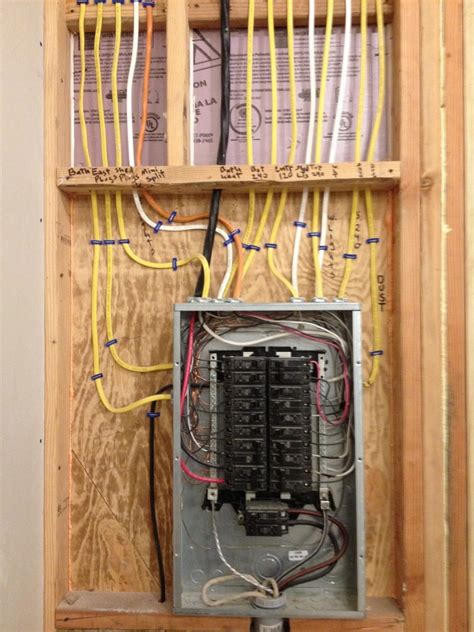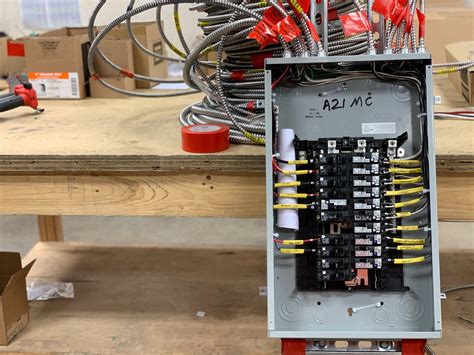electric box at service wire Iirc, the electrical code typically calls for #3 or #4 gauge wire on each phase for 100Amp service. You'd likely need one sensor on each phase . What is a pullbox in electrical installation? In electrical installations, pull boxes serve as indispensable components that ensure both safety and efficiency. Pull boxes are enclosures used to facilitate the pulling, splicing, and maintenance .
0 · types of electrical service panels
1 · residential main electrical panel
2 · residential electrical service panels
3 · residential electrical panel boxes
4 · inside electrical panel box
5 · electrical service panel location
6 · electrical service panel list
7 · best service panels for residential
What is a Junction Box? A junction box is a protective enclosure where electrical wires meet to distribute power to your ceiling lights, outlets, switches, and appliances. This box .
Electrical service entry wiring, service entry cabling (SEC), & the electrical meter: how to inspect for & report service ampacity, service entry defects & hazards. Carson Dunlop Associates' sketch at page top shows where the electrical inspection starts at a residential property.This page gives the necessary increase in electrical service entry wire size for long .How many watts is the capacity of number 4 service wire.? - 2021-09-06 by Nestor - .
Iirc, the electrical code typically calls for #3 or #4 gauge wire on each phase for 100Amp service. You'd likely need one sensor on each phase .
Wiring a panel box is an essential skill for any homeowner or aspiring electrician. It involves connecting the electrical service entrance wires to the breakers and circuits in the panel box, ensuring safe and efficient distribution of electricity . In most jurisdictions, homeowners can install their own electrical service as long as they do the homework, pull the permit, and collaborate with the inspector and the utility company. Changing out an energized, existing . Installation of 100 amp electric service or subpanel needs a #4 AWG copper wire or #2 AWG aluminum or copper-clad wire inside a minimum 1.25 inch, schedule 40 or 80 PVC electric conduit for underground service.
Electrical boxes encase wire connections to protect them from short circuits. They are vital for fire safety and are used for receptacles, ceiling fans, outside outlets, and more. Unless the device is one of the few that . The electrical service masts should not be more than 3-f eet vertically above the roof line; most utilities will require bracing or guy wires for additional support of any mast that is taller than 3-feet. Understand the basics of your home's electrical service panel to keep you safe and your home well-lit and energized. The electrical panel connects the external electrical wires to the home's internal electric system.Electrical service entry wiring, service entry cabling (SEC), & the electrical meter: how to inspect for & report service ampacity, service entry defects & hazards. Carson Dunlop Associates' sketch at page top shows where the electrical inspection starts at a residential property.
Iirc, the electrical code typically calls for #3 or #4 gauge wire on each phase for 100Amp service. You'd likely need one sensor on each phase and keep in mind that you may end up double counting current on 240v appliances though with correct impact on your bill.
types of electrical service panels

According to the NEC, the wire size for 200 amp service is a 3/0 AWG copper wire or 4/0 AWG aluminum wire. You should increase wire size by 20% for every extra 100 feet run to account for voltage drop. For a 200-amp cable size spanning over 200 feet, choose a 500 kcmil copper wire or a 1000 kcmil aluminum wire. The breaker box, or service panel, operates as a central relay point: It takes power from the street, then feeds that power to the different electrical outlets and hard-wired appliances.
heating sheet metal
Wiring a panel box is an essential skill for any homeowner or aspiring electrician. It involves connecting the electrical service entrance wires to the breakers and circuits in the panel box, ensuring safe and efficient distribution of electricity throughout your home or building. In most jurisdictions, homeowners can install their own electrical service as long as they do the homework, pull the permit, and collaborate with the inspector and the utility company. Changing out an energized, existing service, however, is altogether different and is best left to a qualified, licensed electrician. Installation of 100 amp electric service or subpanel needs a #4 AWG copper wire or #2 AWG aluminum or copper-clad wire inside a minimum 1.25 inch, schedule 40 or 80 PVC electric conduit for underground service.
Electrical boxes encase wire connections to protect them from short circuits. They are vital for fire safety and are used for receptacles, ceiling fans, outside outlets, and more. Unless the device is one of the few that contains its own wires, it likely will need an electrical box. The electrical service masts should not be more than 3-f eet vertically above the roof line; most utilities will require bracing or guy wires for additional support of any mast that is taller than 3-feet. Understand the basics of your home's electrical service panel to keep you safe and your home well-lit and energized. The electrical panel connects the external electrical wires to the home's internal electric system.
residential main electrical panel
Electrical service entry wiring, service entry cabling (SEC), & the electrical meter: how to inspect for & report service ampacity, service entry defects & hazards. Carson Dunlop Associates' sketch at page top shows where the electrical inspection starts at a residential property. Iirc, the electrical code typically calls for #3 or #4 gauge wire on each phase for 100Amp service. You'd likely need one sensor on each phase and keep in mind that you may end up double counting current on 240v appliances though with correct impact on your bill.
According to the NEC, the wire size for 200 amp service is a 3/0 AWG copper wire or 4/0 AWG aluminum wire. You should increase wire size by 20% for every extra 100 feet run to account for voltage drop. For a 200-amp cable size spanning over 200 feet, choose a 500 kcmil copper wire or a 1000 kcmil aluminum wire. The breaker box, or service panel, operates as a central relay point: It takes power from the street, then feeds that power to the different electrical outlets and hard-wired appliances.
Wiring a panel box is an essential skill for any homeowner or aspiring electrician. It involves connecting the electrical service entrance wires to the breakers and circuits in the panel box, ensuring safe and efficient distribution of electricity throughout your home or building.
In most jurisdictions, homeowners can install their own electrical service as long as they do the homework, pull the permit, and collaborate with the inspector and the utility company. Changing out an energized, existing service, however, is altogether different and is best left to a qualified, licensed electrician. Installation of 100 amp electric service or subpanel needs a #4 AWG copper wire or #2 AWG aluminum or copper-clad wire inside a minimum 1.25 inch, schedule 40 or 80 PVC electric conduit for underground service.

Electrical boxes encase wire connections to protect them from short circuits. They are vital for fire safety and are used for receptacles, ceiling fans, outside outlets, and more. Unless the device is one of the few that contains its own wires, it likely will need an electrical box. The electrical service masts should not be more than 3-f eet vertically above the roof line; most utilities will require bracing or guy wires for additional support of any mast that is taller than 3-feet.
residential electrical service panels


heavy duty metal enclosure
heater junction box
A junction box is an essential part of the electrical wiring systems for homes and commercial buildings. These metal or plastic boxes house and safely protect a structure's electrical connections. The electrical casings come in .
electric box at service wire|inside electrical panel box